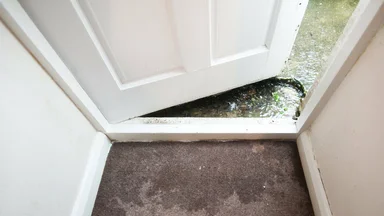Pressure drying: a modern approach to water damage restoration

- Home
- Insights
- Humidity control and drying insights
- Pressure drying: a modern approach to water damage restoration
As buildings continue to meet insulation demands for greater energy-efficiency, the techniques used to dry them out following water damage also needs to evolve. That is why pressure drying is the way forward for contractors to deliver the best results in modern structures.
Historically, the most common method of drying a water-damaged building was a combination of air movement and refrigerant dehumidification systems. These would lift surface water from materials and then gradually evaporate moisture from within these.
This is the traditional approach that many water damage restoration firms maintain to this day. The problem is that modern buildings are not made with traditional materials. The age of stone and brick is rapidly coming to a close, being replaced by structural insulated panels (SIPS), phenolic boards, rockwool batts and similar materials, designed to make buildings as energy-efficient as possible.
What does this mean for the old approaches to drying out water damage? Well first of all, they will always have a place as our older buildings are going to be around for quite some time. Here, we address the need to innovate and evolve within water damage restoration and embrace a technique specifically designed to tackle the challenges posed by multi-layered, energy-conscious buildings – a technique called pressure drying.
Why will traditional approaches to water damage restoration no longer suffice?
First, we want to clarify why it is so important for this upheaval in how contractors and insurers approach water damage restoration projects to happen. The traditional method is wholly dependent on the water’s ability to pass through materials into the air where it can be processed by a dehumidifier.
This was fine when walls, floors, roofs, etc., were made of just one or two layers of materials. For new builds this is no longer the case – it is commonplace for these structures to have extensive layers of materials, often with the aim of preserving the heat within the building.
What is pressure drying?
The permeance and porosity of these materials impacts on the speed at which water (or water vapour) will pass through them. In some instances, such as any insulation made out of plastics, these are impervious to water, meaning it will not pass through and enter the atmosphere to be captured by the dehumidifier.
This traps water within the construction, where it can over time filter down into other layers of the building and cause mould, corrosion and other significant structural damage.
It is not just new builds that need to be considered though. Around 9+ million domestic homes in the UK have received retrofit cavity wall insulation in the past 25 years, and this number is only growing with each year. If contractors are unaware that the building has been retrofitted with insulation, traditional drying methods will not remove all moisture and this leaves the contractor exposed to secondary damage claims.
Simply put, the multi-layered nature of modern buildings does not always facilitate traditional drying techniques. This will only deal with the surface layers, and leave buildings susceptible to further damage from the remaining trapped water. For both contractors and insurers, this can negatively reflect on customer satisfaction.
“I’ve quoted 2 weeks – I can’t dry anymore”
“There must be some form of vapour barrier”
“It’s always going to be wet. It can never be fully dried”
These are some of the rationalisations that water damage restoration contractors and insurers reach when traditional drying techniques fail to get results. However, as we have highlighted, this can often be due to not recognising the building materials, and pivoting drying methods on a case-by-case basis.
For this reason, pressure drying offers the ideal approach to tackling water damage in these more complex modern builds by directly targeting insulated pockets of water.
There are two approaches to pressure drying: positive pressure and suction.
Positive pressure is when dry air is forced under pressure into the cavity of walls, floors, roofs and other areas through tubes surrounding small holes made in the surface layer. This pressured air pushes any trapped water in the layers of the building up towards the surface, where it can then be captured by a dehumidifier.
This is a valid technique, but it does come with a major drawback – contamination. Depending on where the water is trapped, the type of water intrusion, and how long it has been there, it may have become contaminated with dust, mould, bacteria, viruses and other undesirable elements. If this is aerosolised into the living space without sufficient air filtration controls, it can put the health of those using the equipment and anyone still residing in the building at risk.
In addition to this, as these systems generate a lot of heat when forcing hot, dry air into cavity walls, floors and other areas, it is inadvisable to use them during the summer months, as that additional surrounding heat could cause the equipment to fail due to the high ambient temperatures.
For this reason, our own Aerial AERCUBE® utilises suction. Instead of blowing down air that forces water towards the surface, this approach sucks standing water out of any insulation layers, the liquid water is separated and the moisture laden airflow is then filtered through multiple filters. This prevents any contaminated water from entering the atmosphere, protecting the wellbeing of anyone in the area.

It is also far faster than traditional drying techniques. It is approximately 2500 times faster to remove liquid via extraction than it is to wait for the water to evaporate and be collected by a dehumidifier.
Think about it: if you want to empty the bathtub, is it faster to let the water evaporate, or do you pull the plug?
By going beyond the surface and spending a few additional days excavating water from the deeper layers of the building, you can save hours or even full days on overall drying times. For contractors, this means projects are completed more efficiently, opening up the possibility to fulfil more obligations on a monthly or yearly basis.
The push/pull solution
Although there are these two distinct approaches to pressure drying, there is no reason to suggest they cannot work in harmony. In fact, a combination of suction and positive pressure drying, referred to as the “push/pull” approach, represents the fastest way to remove moisture from a water-damaged building

By creating a suction to capture the warm, wet air that is pushed to the surface by a dry air blower, this prevents contaminated air escaping into the room. This means all water trapped in insulation is forced out far faster than using suction alone, without the drawback of potentially contaminating the atmosphere.
Of course, this approach will be more energy-intensive than using one of the systems separately. However, for contractors and insurers that want to turnaround more projects every month or year, this is an effective solution.
Pressure drying and moisture mapping
Moisture mapping is another area that will need to become more thorough to effectively eliminate water damage from complex new build properties. Like pressure drying, it is something that has been overlooked and underutilised in the industry for too long.
Rather than simply checking the surface layers, moisture mapping needs to delve into the deeper layers of the building fabric to locate any pockets of standing water trapped within the layers of insulation.
This is an important and advantageous action for contractors. With a clearer picture of how much water truly needs to be removed from walls, floors, roofs and other areas, they can accurately quote how long the project will last, and earn more on each job as a result since they typically find more water than they otherwise would.
Working alongside a powerful pressure drying solution like the Aerial AERCUBE®, this represents an up-to-date approach to water damage restoration – an approach that is faster, smarter and capable of delivering successful results for the client.
The benefits of the AERCUBE®
The Aerial AERCUBE® is a sophisticated solution designed to rise to the challenge of removing water damage from today’s more complex builds.
Intelligent and user-friendly, the distinct systems found within the AERCUBE® are built to efficiently dry multi-layered constructions through pressure drying in a way that traditional drying techniques simply cannot, while remaining easy to install and apply for contractors on-site.
The AERCUBE® chamber is made of several interchangeable parts, including a turbine or side channel blower, water separator and sound silencer, all there to meet the needs of modern water damage restoration projects
Suction approach prevents the risk of contaminated water entering the atmosphere
All units are accurately designed to allow them to be stacked, stored and transported without the risk of tipping, and are optimised for transportation on pallets
The HF 2 HEPA Filter removes any contaminants from the air - dust, bacteria, viruses, etc. - so that only clean, filtered air is blown into the atmosphere
The system is incredibly energy-efficient and all housing components can be recycled, making it great for the environment
The SD 2 Sound Silencer drops the noise level of these units by up to 19 dB(A), as well as working as a carbon filter to reduce any unpleasant odours
When used in collaboration with a condensation dehumidifier like the AD 20, the AERCUBE® delivers an efficient, cost-effective and comprehensive way to remove moisture from the most heavily-layered materials used in today’s modern buildings and retrofits.
Discover the power of pressure drying today
As buildings both new and old continue to be made or retrofitted with more complex, insulated materials, it is essential that drying techniques evolve to ensure projects are completed efficiently and effectively.
If you were either unaware of pressure drying as a technology, or believed that it was an unnecessary alternative to tried-and-tested approaches, we hope this has cleared up any confusion.
Moving forward, pressure drying needs to be prioritised among water damage restoration contractors and insurers to ensure that sites are properly dried out for their customers, and to allow them to work more efficiently from project to project.
If you would like to learn more about pressure drying or the key features of the Aerial AERCUBE®, get in touch by completing the form below.
Related products
Featured insights

What to do when the atmosphere becomes a hazard

What creates condensation underground?

Expert advice for your next project
Need help with choosing the right solution? Our team of over 100 climate control experts can assist.
You can also reach out or join the discussion on our Social Media. Check out our LinkedIn page.











